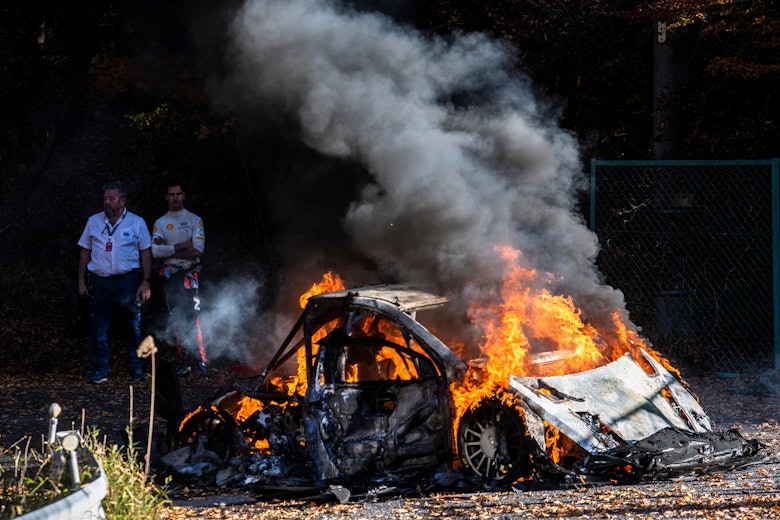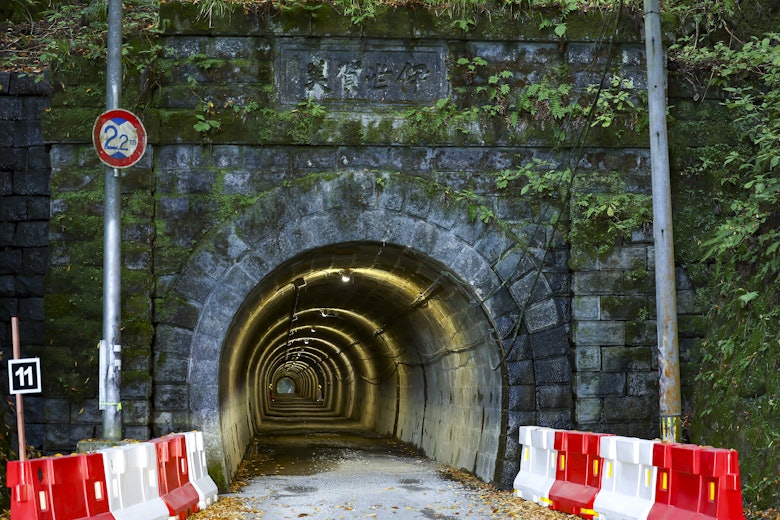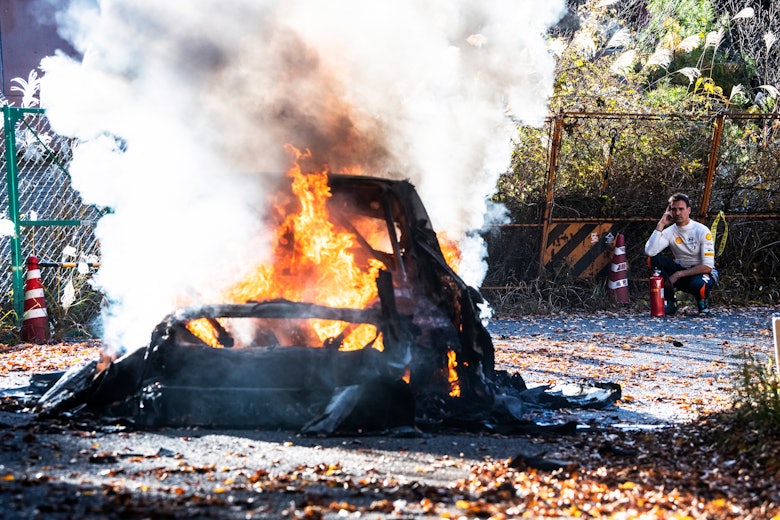Nothing prepares you for a sight like this one. Nothing.
Hyundai i20 N Rally1 chassis #4 appears to have melted into the Aichi asphalt on which it sits.
The previous 45 minutes have been an absolute frenzy of driving up and down route 33 alongside the Dando River, searching the road which will take us to the point between junctions 12 and 13.
Communication with rally headquarters has confirmed the location and granted us permission to walk on a stage long since closed by a dramatic Rally Japan exit for car six.
More sublime map work from Colin Clark gets us to a point 200 meters from the car. We run.
We stop.

Seeing Sordo standing alongside a still-burning Hyundai is a scene as striking as it is sickening.
And it does, momentarily, stop us in our tracks.
The juxtaposition of this smoking, smouldering steel framework sitting among the stunning fall colors of the Japanese Maples is extraordinary.
Sordo and co-driver Cándido Carrera have been stopped here for an hour. They’ve watched the organizers’ intervention vehicle doing its best to quell the flames, but only the full force of the local fire brigade would make a difference.
Standing with Sordo as the fire engines arrive, it’s impossible not to feel his frustration.
Questions have to be raised on this timeline. But for now, the overwhelming emotion is shock.
Visually, the similarities between what sits before us and the remains of a certain Lancia Delta S4 dragged from the bottom of a ravine outside of Corte are striking. To be clear, that’s a reference to what we’re looking at. Advances in safety between Group B and where we are today are night and day.
What’s made the difference, of course, is the return to a tubular chassis. The composite panels have all gone, only the steel bonnet and roof remain. Engine ancillaries have all melted, there’s nothing left inside and still brilliant bright white fires burn as magnesium or aluminium defies the water.
And the battery, we’re told, is still burning.
Such is the visual assault of what we can see here, it takes a moment or two to for the other senses to comprehend. Then it hits you. The smell.
The smell.
Every time water’s shot into the burning chassis, the smoke billows to cloud the beautiful blue sky with the most acrid, choking eye-watering fumes you can imagine.
Sitting typing these words, hours later, the smell still clings to clothes.
In the days leading up to the event, the DirtFish plan was – as always – to take a good look at the roads. Animated in their opinion of Friday morning’s first stage proper, we headed for Isegami’s Tunnel.
https://twitter.com/DirtFishRally/status/1590794371837743104?s=20&t=KsnvC9V3voAjg-cbPWowQw
Anybody who questioned Rally Japan’s switch from Hokkaido gravel to mainland asphalt was provided with a definite answer by this extraordinary 14.53-mile test.
As a whole, the rally was described as ‘Corsica with a few more corners’ but this stage was even more twisty. And with absolutely no room for error. The road is bordered on one side by a continuous drainage channel and a big wheel-wrecking kerb on the other. Precision is everything here.
There’s the odd wider section linking the narrow lanes, but it’s a relentless journey through turn after turn after turn.
Just over half way through a downhill square-right lines you up with Isegami’s Tunnel. Around 100 meters after the junction and you’re sent into the darkness.
And onto the gravel.

To be precise, this is Old Isegami Tunnel, there’s a new one on another road. This one was constructed in 1897 and is the source of no shortage of local legend and legacy. Stand in the tunnel at a certain time, on a certain day, and the lights flicker for no reason. Look through a camera lens and you’ll see ghosts of souls lost during the Ise Bay Typhoon in 1959.
Spooky stuff.
Turning and coming back through in a cloud of our own dust adds something of the mysterious to the job, but there’s not much take up for the supernatural. Tunnel done, the decision is taken, the usual process of talking to the drivers ahead of the day’s opening stage will be binned on Friday.
We had to be at the end of Isegami’s Tunnel.

Ultimately, Sordo’s fire had little to do with the road he was running, but it was hard to imagine a more dramatic start to Friday.
Returning to Toyota City and service after reporting on the fire, we offered Sordo a lift back down the road. His response was telling.
“No,” he said. “I want to stay here. It sort of feels like a funeral for the car – you don’t leave a funeral early.
“Honestly, I feel so bad for the team. This car, it’s like our baby and to see what happened here this morning is too much.”
Too much was about right.
While he wouldn’t take our lift, he would take our sweets. Walking back up the road to retrieve a packet of Milkys for our favorite Spaniards, there was an overwhelming sense of gratitude that Dani and Cándido were with us and ready, willing and able to debate whether to take our Mentos as well.
Chassis #4’s dramatic departure has added a further chapter to the ghostly tales of Isegami’s Tunnel.







